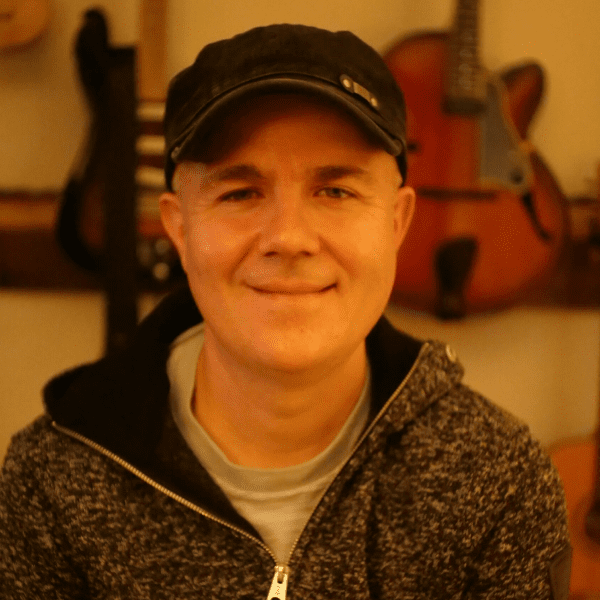
One of the most popular queries amongst students at all levels is “how can I learn my fretboard?”. There are many players who have incredible technique and natural music ability who still have very little understanding of the notes that they’re actually playing.
Why is learning the guitar fretboard so important?
Think of learning the guitar fretboard as your typewriter/computer keyboard. As you’re writing, you want to be able to get the ideas out as quickly as they are coming to you. In another analogy, knowing your way around a complex piece of software for recording or mixing. You know what you want to record, and what it should sound like… but you simply don’t know your way around the software yet to facilitate what you want to do with it. In similar fashion, it’s the same with the neck. It’s fascinating how I can I ask experienced students to play within certain parameters and they really have to think about how to execute.
How do I start learning the guitar neck?
There’s no one way to do this. When I got to Berklee, I was clearly deficient in this area so there was a lot of trial by fire happening. Reading music was a huge part of it as it was a necessary skill to keep up in the classes. Also, I was playing a lot of jazz music which tended to be in flat keys which I was not that fluent in. If I was playing in an ensemble, I would often have to improvise and play rhythm guitar. What I found was when I got to creating my own music or playing in church bands, I had a much wider vocabulary to draw from which all started with knowing the fretboard intimately.
Here are some basic fretboard activities you can do to start.
- Read music every day. Doesn’t have to be a whole song, but read something every day. Even if it’s a song you already know, try playing the chords or melody in a different part of the neck or a different octave above or below what’s written.
- Practice playing triads in all inversions on all string groups. Three note chords on strings 1-3, 2-4, 3-5, 4-6. Major, Minor, Augmented, Diminished in all 3 inversions up and down the neck on one set of strings. Then move to the next set of strings.
- Practice playing scales and improvising on 1 string at a time. This is huge. Many guitarists are inured in patterns when they play. This is one way to break out of that. You have to “see the notes” as they happen as every string is different.
- Practice improvising in keys you’re not familiar with. Guitarists are notorious for not being fluent in flat keys… which many jazz standards happen to be in. IE: On Youtube, call up a Blues Jam Track in Ab or F#… and go.
- Practice playing bass lines… Either learn a bass line from a bass chart, or invent one yourself for a particular song, or learn one by ear. If learning by ear, try to map out the notes in the bass line, and how they correspond to the harmony of the tune. Walking bass lines are great because they weave in and out of the chord changes.
- Play with other musicians as much as possible. Think of jamming as having a conversation with other musicians. Sometimes you can lead the conversation and sometimes you’re responding to someone else. You have to make choices in real time that you haven’t necessarily prepared for in advance. It’s a good gauge to see how well you do or don’t know your neck.
- Arrange songs from other instruments on guitar. A good example would be to take some piano based music and try and play it on guitar. IE… I found myself having to play the song “Drops Of Jupiter” on guitar… which is very piano driven. At other times, taking an upbeat jazz standard like “Got A Match” by Chick Corea and mapping out the melody on guitar.
In all of these activities, leaning on patterns and pattern memorization is suspended for a moment. Patterns have their place and are useful, but they are the antithesis of learning/knowing the neck in terms of knowing what notes you’re playing at all times.
Wait, I’ve heard about the CAGED system… should I learn it?
Let’s put it this way, if you are working through the 7 prescriptions I’ve laid out for learning the fretboard, you won’t really need it. To me, it’s a supplement, not a meal. Being healthy in life is not about how many supplements you take. It’s your lifestyle: diet, sleep, exercise, water intake, active social life, etc.
So too it is with the guitar neck. The more situations you get involved with, the better you’ll know it. Playing in different keys all the time. Improvising up and down the neck. Voice leading chord sequences. These will by far get into your playing faster and stay with you for longer.
My advice in closing is take one of the 7 tips at a time and work on it. Learning the neck is literally a hands on experience. You have to actually do those things… many many times. Repetition is the mother of skill.
Want some personalized guidance in learning your neck? Check out my 1 on 1 online course on Learning the guitar neck!


